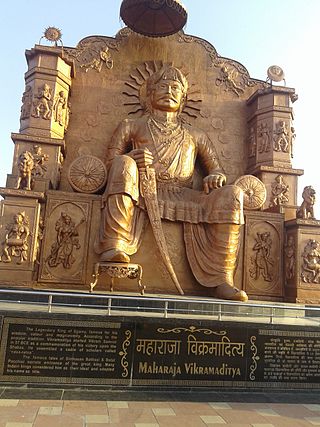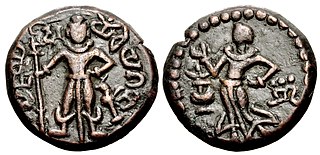
Chandragupta Maurya was the founder of the Maurya Empire, a geographically-extensive empire based in Magadha. He reigned from 320 BCE to 298 BCE. The Magadha kingdom expanded to become an empire that reached its peak under the reign of his grandson, Ashoka the Great, from 268 BCE to 231 BCE. The nature of the political formation that existed in Chandragupta's time is not certain. The Mauryan empire was a loose-knit one with large autonomous regions within its limits.
The Gupta Empire was an ancient Indian empire on the Indian subcontinent which existed from the early 4th century CE to early 6th century CE. At its zenith, from approximately 319 to 467 CE, it covered much of the Indian subcontinent. This period has been considered as the Golden Age of India by historians, although this characterisation has been disputed by some other historians. The ruling dynasty of the empire was founded by Gupta and the most notable rulers of the dynasty were Chandragupta I, Samudragupta, Chandragupta II, Kumaragupta I and Skandagupta.

Chandragupta II, also known by his title Vikramaditya, as well as Chandragupta Vikramaditya, was the third ruler of the Gupta Empire in India. Modern scholars generally identify him with King Chandra of the Delhi iron pillar inscription.

A petroglyph is an image created by removing part of a rock surface by incising, picking, carving, or abrading, as a form of rock art. Outside North America, scholars often use terms such as "carving", "engraving", or other descriptions of the technique to refer to such images. Petroglyphs, estimated to be 20,000 years old are classified as protected monuments and have been added to the tentative list of UNESCO's World Heritage Sites. Petroglyphs are found worldwide, and are often associated with prehistoric peoples. The word comes from the Greek prefix petro-, from πέτρα petra meaning "stone", and γλύφω glýphō meaning "carve", and was originally coined in French as pétroglyphe.

The Edicts of Ashoka are a collection of more than thirty inscriptions on the Pillars of Ashoka, as well as boulders and cave walls, attributed to Emperor Ashoka of the Maurya Empire who reigned the Indian subcontinent from 268 BCE to 232 BCE. Ashoka used the expression Dhaṃma Lipi to describe his own Edicts. These inscriptions were dispersed throughout the areas of modern-day Bangladesh, India, Nepal, Afghanistan and Pakistan, and provide the first tangible evidence of Buddhism. The edicts describe in detail Ashoka's view on dhamma, an earnest attempt to solve some of the problems that a complex society faced. According to the edicts, the extent of Buddhist proselytism during this period reached as far as the Mediterranean, and many Buddhist monuments were created.

The Mintaka Pass or Mingteke Pass or Mintika Pass(Chinese: 明铁盖达坂) is a mountain pass in the Karakorum Mountains, between northern Pakistan and Xinjiang in China. In ancient times, the Mintaka Pass and the nearby Kilik Pass, 30 km (19 mi) to the west, were the two main access points into Gojal from the north. The Hunza Valley is a mountainous valley near Gilgit in the Gilgit-Baltistan region of Pakistan. In addition, the two passes were also the routes used to reach Chalachigu Valley and Taghdumbash Pamir from the south. The name of the pass – Mintaka means "a thousand ibex" in Kyrgyz.

The Kilik Pass to the west of Mintaka Pass is a high mountain pass in the Karakorum Mountains between Gilgit-Baltistan in Pakistan and Xinjiang in China. The two passes were, in ancient times, the two main access points into the Upper Hunza Valley from the north. In addition, the two passes were also the paths used to reach Chalachigu Valley and Taghdumbash Pamir from the south.

The Udayagiri Caves are twenty rock-cut caves near Vidisha, Madhya Pradesh primarily denoted to the Hindu gods Vishnu and Shiva from the early years of the 3rd century CE to 5th century CE. They contain some of the oldest surviving Hindu temples and iconography in India. They are the only site that can be verifiably associated with a Gupta period monarch from its inscriptions. One of India's most important archaeological sites, the Udayagiri hills and its caves are protected monuments managed by the Archaeological Survey of India.

Vikramaditya was a legendary king mentioned in ancient Indian literature, featuring in traditional stories including those in Vetala Panchavimshati and Singhasan Battisi. Many describe him as ruler with his capital at Ujjain. "Vikramaditya" was also a common title adopted by several monarchs in ancient and medieval India, and the Vikramaditya legends may be embellished accounts of different kings. According to popular tradition, Vikramaditya began the Vikrama Samvat era in 57 BCE after defeating the Shakas, and those who believe that he is based on a historical figure place him around the first century BCE. However, this era is identified as "Vikrama Samvat" after the ninth century CE.

Yaudheya (Brahmi script: 𑀬𑁅𑀥𑁂𑀬) or Yoddheya Gana (Yoddheya Republic) was an ancient militant gana (confederation) based in the Eastern region of the Sapta Sindhu. The word Yaudheya is a derivative of the word from yodha meaning warriors and according to Pāṇini, the suffix '-ya', was significant of warrior tribes, which is supported by their resistance to invading empires such as the Kushan Empire and the Indo-Scythians. Rudradaman I of the Western Satraps notes in his Junagadh rock inscription that the Yaudheyas were 'heroes among all Kshatriya' and 'were loath to surrender'. They were noted as having a republic form of government, unique from other Janapadas which instead maintained monarchies.

Chilas is a city in Pakistani-administered Gilgit–Baltistan in the disputed Kashmir region. It is the divisional capital of Diamer Division and is located on the Indus River. It is part of the Silk Road, connected by the Karakoram Highway and N-90 National Highway to Islamabad and Peshawar in the southwest, via Hazara and Malakand divisions of Khyber Pakhtunkhwa. To the north, Chilas connects to the cities of Tashkurgan and Kashgar in Xinjiang, China, via Gilgit, Aliabad, Sust, and the Khunjerab Pass.

The Hunza Valley is a mountainous valley in the northern part of the Gilgit-Baltistan region of Pakistan.
Afghanistan possesses a rich linguistic legacy of pre-Islamic scripts, which existed before being displaced by the Arabic alphabet, after the Islamic conquest of Afghanistan. Among these scripts are Sharada, Kharosthi, Greek, and Brāhmī. For thousands of years, Afghanistan was inhabited by Indo-Aryan and Iranian peoples and thus all ancient documents, tracts, monuments and remains are of Hindu and Iranian origins. Later, Buddhism became the major force in Afghanistan and brought with it its own liturgical languages.
Gilgit-Baltistan is an administrative territory of Pakistan that borders the province of Khyber Pakhtunkhwa to the west, Azad Kashmir to the southwest, Wakhan Corridor of Afghanistan to the northwest, the Xinjiang Uyghur Autonomous Region of China to the north, and the Indian-administered region of Jammu and Kashmir to the south and south-east.

Mansehra Rock Edicts are fourteen edicts of the Mauryan emperor Ashoka, inscribed on rocks in Mansehra in Khyber Pakhtunkhwa, Pakistan. The edicts are cut into three boulders and date back to 3rd century BC and they are written in the ancient Indic script of Gandhara culture, Kharosthi. The edicts mention aspects of Ashoka’s dharma. The site was submitted for inclusion in the World Heritage Sites and is currently in the tentative list.
Shatial is a transit station with archaeological significance on Karakoram Highway in Gilgit-Baltistan region of northern Pakistan.
The Vasu Doorjamb Inscription is an early 1st-century CE Sanskrit inscription in Brahmi script dedicated to the deity Vāsudeva, related to the Vaishnavism tradition of Hinduism. It is also one of the several dedicatory inscriptions from Mathura bearing the name of the Indo-Scythian Northern Satrap ruler Sodasa, which are useful as historic markers for the first half of the 1st century CE.
The Ancient Rock Carvings of Sindh have been explored in Kirthar Mountains Range, Sindh, Pakistan. The Kirthar Mountains Range covers a distance of 190 miles in boundaries of Jacobabad District, Qambar Shahdadkot District, Dadu District and Jamshoro District from north to south up to Karachi, Sindh.
The Legendary account of Vikramaditya, as attributed to the renowned 4th-century CE Sanskrit poet Kalidasa and further elaborated upon in the Brihatkathamanjari by the Kashmiri writer Kshmendra, unveils a compelling narrative of a powerful and ambitious ruler who left an indelible mark on the Indian subcontinent. Some modern historians link this legend to Chandragupta II as being Vikramaditya, yet even so, it remains a speculative assertion.
Janine Mountain is located in the Ha'il region in the middle of Lake Janine, which is rich in groundwater and has a large cave about 100 meters long. There are many ancient Thamudic and Abyssinian inscriptions scattered on the rocks of the mountain, in addition to a large collection of human and animal writings and drawings. Janine is located about 75 km east of Ha'il.















